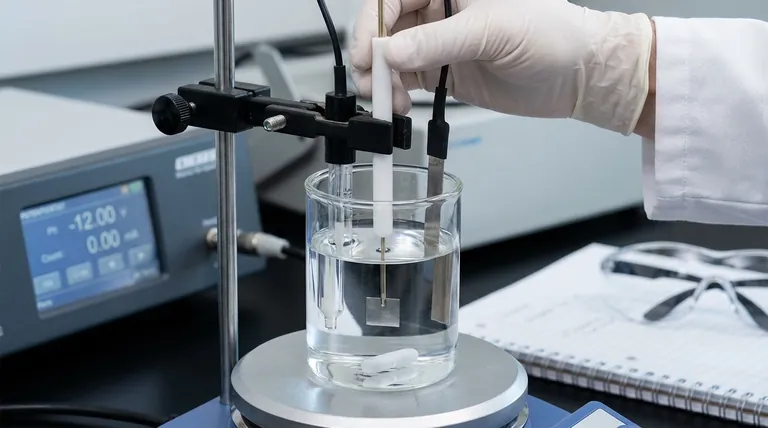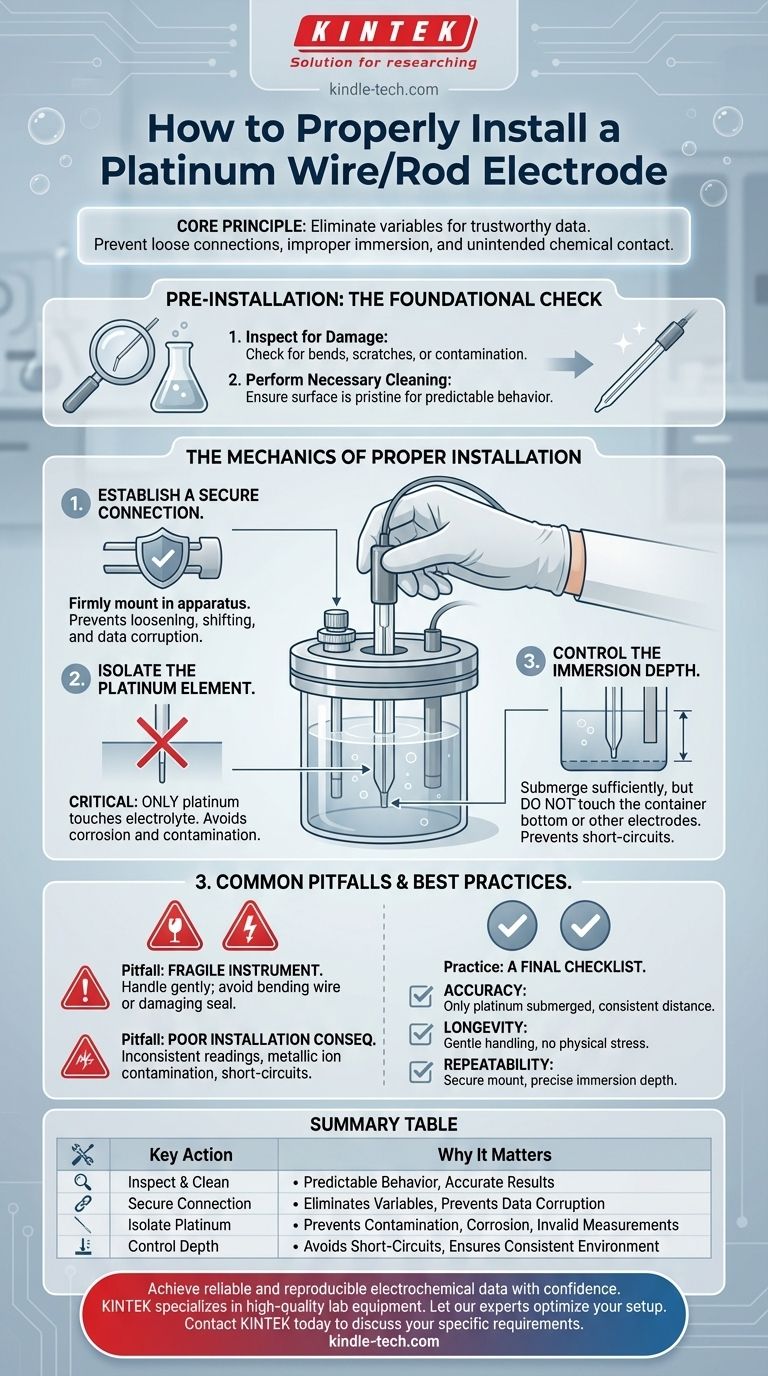Properly installing a platinum wire or rod electrode is a critical step that hinges on three key actions: creating a stable physical connection, controlling the immersion depth, and ensuring only the platinum element itself makes contact with the electrolyte. These steps are fundamental to preventing experimental errors and preserving the integrity of the electrode.
The core principle behind correct installation is eliminating variables that can corrupt your data. A loose connection, improper immersion, or unintended chemical contact will introduce significant, uncontrolled interference, rendering your electrochemical measurements unreliable.

Pre-Installation: The Foundational Check
Before you begin the installation, a brief inspection is necessary to ensure the electrode is in optimal condition for the experiment.
Inspect for Damage and Contamination
The electrode surface must be pristine. Check for any visible damage, such as bends or deep scratches in the wire or rod.
Also, look for any signs of contamination or residue. A clean, smooth surface is essential for predictable electrochemical behavior.
Perform Necessary Cleaning
If you find any stains or obvious contamination, the electrode must be cleaned and treated before use. Scratches or surface impurities can significantly alter the electrode's active surface area and affect measurement results.
The Mechanics of Proper Installation
Correct physical placement is about creating a stable and controlled environment for the electrochemical reaction to occur.
Establish a Secure Connection
The electrode must be firmly mounted in your testing apparatus, such as the cell lid or holder. This connection must be secure enough to prevent any loosening or shifting during the experiment.
Any movement can change the electrode's position relative to others, altering the electrochemical environment and skewing your data.
Isolate the Platinum Element
This is an absolutely critical rule: only the platinum part of the electrode should ever touch the electrolyte.
Contact between the electrolyte and any other part of the electrode assembly (like the housing or connector) can lead to corrosion, contamination of your solution, and invalid results.
Control the Immersion Depth
When inserting the electrode into the electrolyte, carefully manage how deep it goes.
The platinum wire or rod must be submerged sufficiently to serve its function (often as a counter electrode) but must not touch the bottom of the container or any other electrode in the cell. Direct contact can cause a short-circuit and will invalidate the measurement.
Common Pitfalls and Best Practices
Avoiding common mistakes is just as important as following the correct procedure. A platinum wire electrode is a delicate and often expensive instrument.
Handling with Care
Due to its construction, a platinum wire electrode is fragile. Always handle it gently to avoid bending the wire or damaging the seal between the wire and its housing.
The Consequence of Poor Installation
A loose electrode can lead to inconsistent readings as the distance to other electrodes fluctuates.
Allowing the non-platinum components to touch the electrolyte can introduce metallic ions into your solution, contaminating the experiment. An electrode touching another surface can cause a short-circuit, potentially damaging your potentiostat.
A Final Checklist for Your Setup
Use these points to verify your installation before beginning any measurement.
- If your primary focus is accuracy: Double-check that only the platinum surface is submerged and that it is a consistent, stable distance from your other electrodes.
- If your primary focus is equipment longevity: Ensure the electrode is handled gently and that no part of it is under physical stress or in contact with other surfaces inside the cell.
- If your primary focus is repeatability: Confirm that the electrode is secured tightly and its immersion depth is precisely the same as in previous experiments.
Ultimately, a methodical and careful installation is the foundation for trustworthy and reproducible electrochemical data.
Summary Table:
| Installation Step | Key Action | Why It Matters |
|---|---|---|
| Pre-Installation | Inspect for damage and clean the electrode surface. | Ensures predictable electrochemical behavior and accurate results. |
| Secure Connection | Firmly mount the electrode in the apparatus to prevent movement. | Eliminates variables that can corrupt data from shifting positions. |
| Isolate Platinum | Ensure ONLY the platinum part contacts the electrolyte. | Prevents solution contamination, corrosion, and invalid measurements. |
| Control Depth | Submerge sufficiently without touching the cell bottom or other electrodes. | Avoids short-circuits and ensures consistent electrochemical environment. |
Achieve reliable and reproducible electrochemical data with confidence. Proper electrode installation is fundamental to your lab's success. KINTEK specializes in high-quality lab equipment and consumables, including precision electrodes, to meet your exact testing needs.
Let our experts help you optimize your setup. Contact KINTEL today to discuss your specific requirements and ensure your equipment delivers peak performance.
Visual Guide

Related Products
- Platinum Sheet Electrode for Battery Lab Applications
- Platinum Sheet Electrode for Laboratory and Industrial Applications
- Rotating Platinum Disk Electrode for Electrochemical Applications
- Platinum Auxiliary Electrode for Laboratory Use
- Gold Disc Electrode
People Also Ask
- How can a worn or scratched platinum disk electrode surface be restored? Achieve a Mirror Finish for Reliable Data
- What are the performance characteristics of platinum wire/rod electrodes? Unmatched Stability for Your Lab
- What can cause poisoning of a platinum disk electrode and how can it be prevented? Ensure Reliable Electrochemical Data
- What are the available specifications for platinum sheet electrodes? Find the Perfect Fit for Your Electrochemical Needs
- What is the most critical guideline for immersing a platinum sheet electrode in an electrolyte? Ensure Accurate Electrochemical Measurements



















